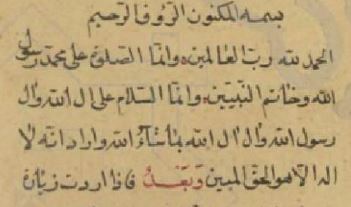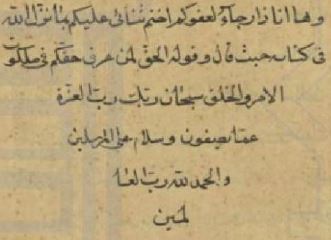
Opening lines of the Tehran, Majlis Library, Baqir Naraqi ms.
al-Ziyāra al-jāmi'a al-kabīra ("TheGrester Visitation Tablet") of the Bab.
Introduction and Translation al-Ziyāra al-jāmi'a al-kabīra ("TheGreater Visitation Tablet") of the Bab.
Stephen Lambden
In progress 2017.
Mss. of al-Ziyārat al-jāmi`a al-kabīra (ZJK) of the Bāb are listed by MacEoin in his Sources, 202:
- (1) Cambridge, Browne F.22 (item 1).
- (2) Tehran, INBA 6003C, pp. 132-45 (incomplete)
- (3) Tehran, INBA 6009C, pp. 173-219 (incomplete; dated 1267/1851)
- (4) Iran, INBMC 50: 1-72
- (5). Russia (?), Kažem Beg copy. (MacEoin, Sources, 202)/
Additionally we may note
- (6) Tehran, Majlis Library, Baqir Naraqi ms. ( PDf. on this website). Translated below,
Like its Shī`ī namesake, the lengthier Ziyāra visitation text of the Bāb is quite extensive. It occupyies about twenty-five pages of 15 lines per page in the Majlis Lib, ms. (see bib.). It commences with the title followed by a standard glorification of God, then a new rhyming basmala formula. The recitation of this ZJK should be preceeded by some detailed and demanding preparatory ritualistic directives, several of which echo those of its Shī`ī counterpart. They include ablutions (ghuṣl) with seven handfuls of water, dressing in the “best of clothing”, applying “suitable perfume” (al-`iṭr) and uttering a Ka`ba oriented beseeching of “the forgiveness of God, thy Lord, two-hundred and two times”, this number being the abjad numerical value of the divine Name Rabb (“Lord”) and that of the parentally bestowed name of the Bāb (`Alī Muhammad) himself. The devotee should then silently enter the shrine, “move forwards in peaceful repose” until seven walking paces away stand still and say, “I bear witness from my [lowly] position (fī maqāmī) that this is the Throne of the Lord (`arsh al-rabb) for God Himself does so testify through His own Self in such wise as none can ever befittingly estimate. He, verily, no God is there except Him, the Mighty, the All-Wise” (al-Ziyāra al-jāmi`a al-kabīra, Majlis ms. pp.145-6). Further details of this lengthy and sometimes complex Ziyāra text cannot be registered here
♦
The al-Ziyārat al-jāmi`a al-kabīra (ZJK) of the Bāb.
Translation Stephen Lambden
IN PROGRESS 2017. Last uploaded 19-01-2017
![]()

Opening lines from the Tehran Majlis Baqir Naraqi ms.
In His Name,
the One Hidden (al-maknun), the One Benevolent (al-ra'uf), the Compassionate (al-rahmin).
Praised be to God, the Lord of all the worlds. And may prayerful devotion [peace] (al-salat) be upon Muhammad, the Messenger of God, and the Seal of the Prophets (khatam al-nabiyyin). May peace (al-salam) be upon the [Shi`i] family of Gof and the family of the Messenger of God as well as upon the family of the family of God for God hath willed and desired that there be no God except Him, the Ultimately Real [True One] (al-Haqq), the One Clearly Evident (al-mubin). And now ...
ADD TRANS. HERE
The concluding lines of the al-Ziyārat al-jāmi`a al-kabīra of the Bāb (Majlis ms. unpaginated) are as follows:.

♦
A Note on the Ziyārat al-jāmi`a reference in directive six of the Khasa'il-i Sab`a (KS).
"And the sixth [directive of the new Babi religion] of them involves the recitation of the Ziyārat al-jāmi`a which was originated by him [the tenth Imam `Alī al-Hādī, d. 254/868] -- may blessings and peace be upon him -- with his blessed voice (bi-lafẓihi al-mubāraka), at all gatherings [Fridays] (kull jum`a), at festivals (`īd) and on every blessed day (yawm mutabarak) and felicitous night (layl sa`īd)" (Directive six of the 1845 Khasa'il-i sab`ah of the Bab trans. Lambden).
In KS6 the adjectives al-saghīra (“lesser”, “shorter”) or al-kabīra (“greater”, “longer”) are not present. The Bāb simply refers to al-Ziyāra al-jāmi'a, `The Comprehensive Visitation text’. This leaves KS6 open to four possible devotionalistic identifications : (1) the shorter ZJS, (2) the longer ZJK or twelver Shī`ī version of the al-Ziyāra al-jāmi'a, or, alternatively (3-4) the shorter or longer versions of the Ziyara of the Bāb himself. [1] Each of these four Ziyāra (visitation) texts, it should be noted here, have various ritual acts and recitations associated with their utterance.
The text of the Ziyāra referred to in KS6 is said to have originated with a very elevated figure possessed of a lafẓihi al-mubāraka, (loosely) a “blessed utterance / voice”. This, almost certainly, is a reference to one of the twelver Imams. Several of these twelver Imams are associated with the authorship or transmission of the ZJS and the ZJK. The shorter ZJS is sometimes linked with the person of the seventh Imam Mūsā al-Kāẓim (d.183/799) or (more frequently) with his son the eighth Imam `Alī al-Ridā’ (d.203/818). The longer ZJK is especially associated with the tenth Imam Muhammad ibn `Alī al-Hādī known as al-Naqī (d. Samarra, 254/868). Having said this it should be noted that various twelver Shī`ī sources themselves exhibit some uncertainty on aspects of authorship issues surrounding these two Shi`i Ziyāra texts discussed here. It would seem most likely then, that the focus of blessing upon the author of “immaculate voice” points to Imam `Alī al-Hādī, the source of the very highly regarded twelver Shī`ī larger comprehensive Ziyārat devotional supplication,
That the one referred to is Imam `Alī al-Hādī is more or less confirmed by the use made by the Bāb of similarly pious expressions such as the use of the taslīm (`alayhi al-salām, `upon him be peace’) after the mention of the name of Imam `Alī (cf. also KS7). Of the many examples, we may note this exression towards the beginning of the Bāb’s commentary on the ḥadith man `arafa nafsa-hu… (`Whoso knows his self…’ in ms. TBA 6006C, 63) and the commencement of the Tafsīr naḥnu wajh-Allāh (`We are the Face of God’ in ibid, p. 69). Perhaps also confirmatory of the comprehensive Ziyāra being that ascribed to Imam `Alī al-Hādī, might be the fact that it follows reference to the Imam Ḥusayn centered devotionalism of KS5 which is also imamologically echoed in KS7 (see below). The longer twelver Shī`ī prayer of visitation transmitted through the tenth Imam `Alī al-Hādī is a (roughly) eight to ten page Ziyara devotional. That of the Bāb is similarly named and about twice as long, with twenty-five or so pages which probably date to sometime between 1843 and 1845. Six
In partial illustration of the numerous devotional occasions referred to in KS6 we may draw attention to the fact that the Bāb himself composed numerous devotional compositions for sacred occasions and sacred festivals (pl. a`yād; sing. `īd). This is illustrated in his late 1844 Ṣaḥīfa bayn al-Ḥaramayn and early (pre-June 1845) Ṣaḥīfa makhzūna (or Du`ā-yi ṣaḥīfa) wherein the Bāb himself sets forth devotionals for fourteen or more sacred days and festivals. Among many other occasions, Shī`ī Muslims celebrate, for example, [1] the `Īd al-Ghadīr, `Festival of Ghadīr Khumm’ (18th Dhū’l-Ḥijja) in celebration of the nomination of Imam `Alī as successor to the Prophet; [2] The celebration of the breaking of the fast of Ramaḍān or `Īd al-Fiṭr (1st Shawwāl) and [3] the pilgrimage related `Īd al-Aḍḥā `Feast of the Sacrifice’ (10th of Dhū’l-Ḥijja) and [4] `Īd al-`Arafa (9th of Dhū’l-Ḥijja) as well as [5] the `Īd al-Akbar `The Greatest Festival’ (9th of Rabī` I) in celebration of the commencement of the Imamate of the hidden twelfth Imam.
We may further note here that the Bāb may not have intended that all the preliminary rituals associated with the ZJK be carried out in obedience to the demands of KS6. Rather, this devotional text be recited in a personalistic fashion on the turbat al-Ḥusayniyya (see KS5) and on the numerous sacred occasions that he spells out in KS6.
In the third volume of his bulky commentary on the Shī`ī Ziyārat jāmi`a al-kabīra, it should be noted here, al-Aḥsā’ī devoted more than fifty dense pages to a discussion of the eschatological role and return of Imam Ḥusayn (al-Aḥsā’ī, Sh-Ziyāra, III pp. 48-101). The focus on Ḥusayn in KS5-6 is almost certainly related to the fact that Imam Ḥusayn was expected to return first and transform the world. Early, nascent al-Shaykhiyya (Shaykhism) made much of the return of Imam Ḥusayn and this is mirrored through the close attention given to this Imam in the KS and other early expressions of the religion and claims of the Bāb.
Having said all this, it is not impossible that one of the Bāb’s own comprehensive Ziyāra (Visitation) texts is intended in the KS6 text. This could be thought to utimately derive from the occulted, hidden Imam himself. This latter possibility, however, seems less likely since the language of KS6 does not contain reference to any specific epithet of the supreme, hidden Imam or to, for example, his titles Dhikr-Allāh (Remnant of God) or Baqiyyat-Allāh (Remnant of God) directly or indiorectly referring to the Bab himself. The Imami Shi`i ZJK was so highly regarded by Shaykh Ahmad al-Ahsa'i, that the Bab further underlined the centrality of its frequent recitation in his first legalistic faith affirmative work, in the sixth directive of the Khasa'il-i sab`ah.
The times for the recitation of the al-Ziyāra al-jāmi'a of KS6 cannot be taken up in detail here. It must suffice to note that the recitation of the Ziyāra referred to in KS6 is quite frequent, being every Friday or at all gatherings (kull jum`a) as well as at the numerous Islamic festivals (`īd) or “on every blessed day (yawm mutabarak) and felicitous night (layl sa`īd)" (KS6). With all its surrounding rituals this is a heavy requirement especially if a longer al-Ziyāra al-jāmi'a text of `Alī al-Hādī or the Bāb himself is intended. Despite the ambiguity of the reference to the al-Ziyāra al-jāmi` in the Khasa'il-i sab`ah, some Bahā’ī writers are confidently specific about which Ziyāra text is intended in KS6. While, for example, Muhammad `Alī Fayḍī in his biography of the Bāb understands KS6 to refer to an unidentified (Shī`ī or Bābī?) al-Ziyārat al-jāmi'a al-kabīra (Nuqṭa-yi ūlā, 53-54), Ishrāq Khavārī refers to it in as al-Ziyārat al-jāmi'a al-badī`a (`The new [wondrous] Comprehensive Visitation text’) adding expository details (in Persian) making it very likely that he thought this meant a Ziyāra work of the Bāb himself, and most probably the longer text (see Muḥaḍirāt II, p.785-6). MacEoin follows these writers speaking of the lengthier Ziyāra version most probably of the Bāb himself (Sources, p. 62 cf. pp. 45-6),
In KS6 we have another example of imamo-centric devotionalism which reinforces the elevated Husayn centered directives so central to the eschatologically charged mind of the Bāb. The probable recital of the longer Shī`ī Ziyarat al-Ja`mi`a stipulated by the Bāb in KS6, is again centered on the Prophet and his family which includes the twelve Imams. KS5 is focused on devotion to Imam Ḥusayn and KS6 expands and consolidates this deep imamolocentric piety.



